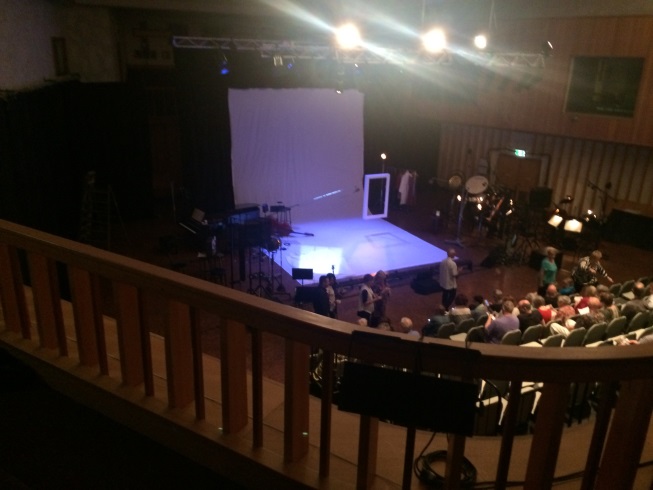[2015161] The Cardinals
Stan’s Cafe @ Flinders St Baptist Church
4:00pm, Sat 14 Mar 2015
As I took my seat pew in the Flinders Street Baptist Church (I’d only attended a performance here once before), I paused to take a deep breath: this was my final Festival show for the year. The church was chockers, silver hair all over the place, and my arrival only five minutes before starting time forced my position into the wings… a bit of shuffling was required until the large puppet booth – already onstage – was not obscured by the church’s supporting pillars.
Three eponymous Cardinals use the puppet booth to present a show with an evangelical message; but, in an opening twist, the puppets have been waylaid, leading to the Cardinals having to improvise in the telling of their story. We, the audience, are privy to the performance and frantic re-working of their show… and that brings forth a lot of physical comedy.
The entire show is performed without dialogue (with the exception of the occasional squeal or yelp for comic effect). And despite the cartoonish qualities of the Cardinals’ clowning, there’s a sincere solemnity to their performance… and an air of exasperated resignation around their female Muslim stage manager.
The Cardinals attempts to work on many levels: there’s the physical creativity and meta-theatre of the Cardinals’ puppetry, and the interactions between the cast – the stage manager’s break for prayer amidst an all-hands-on-deck crucifixion scene was both funny and thoughtful. But the story they try to tell through their puppetry – an abridged version of The Bible (with a little contemporary creative license thrown in) – has its own highlights… including a sequence where the Cardinals depict modern terrorist attacks, eliciting gasps from the audience and consternation between the Cardinals and their stage manager.
This is all fun… but it’s not that much fun, and any deeper significance to the plot was completely lost on me. And, more to the point, this has all the trappings of a polished $30 Fringe show in a fancy venue, rather than a Festival show with a 50% premium on the ticket. And that is the thing that kinda upsets me about the inclusion of The Cardinals in the Festival programme; sure, it’s nice to offer companies like Stan’s Cafe international exposure, but I prefer the theatre slots in a Festival programme to be filled by the big and brazen productions that don’t really have a chance elsewhere.
(161) The Cardinals: Polished anti-puppetry with sly digs and a sting in the tail. #ff2015 #ADLfest
— Pete Muller (@festivalfreakAU) March 14, 2015


